The low vibration thermostat market is valued at USD 133.1 million in 2025 and is expected to reach USD 206.7 million by 2035, supported by rising demand for stable thermal environments in scientific instrumentation, precision material testing, and biological sample handling. These systems are increasingly incorporated into laboratories and manufacturing environments where vibration interference can distort experimental readings, measurement calibration, or microfabrication accuracy. Low vibration thermostats are essential in research fields involving optical instrumentation, semiconductor testing, cryogenic analysis, and cell culture stability. Their relevance continues to grow as global R&D investment expands and sensitive analytical methods require controlled-temperature conditions to maintain reproducibility and measurement fidelity.
From 2025 to 2030, the market progresses from USD 133.1 million to approximately USD 165.9 million, adding USD 32.8 million in value and accounting for 45 percent of total decade growth. This period is characterized by accelerated procurement in biomedical laboratories, university research centers, and metrology facilities, where laboratory-grade low vibration systems become standard equipment. Demand centers on precise temperature uniformity, minimal external interference, and automated digital control features. From 2030 to 2035, growth continues to USD 206.7 million, adding USD 40.8 million or 55 percent of total decade expansion, driven by adoption in industrial-grade applications such as precision manufacturing, semiconductor processing, and advanced optics production. Suppliers offering integrated monitoring platforms and compatibility with laboratory management systems maintain competitive positioning as operational stability becomes an essential performance benchmark.
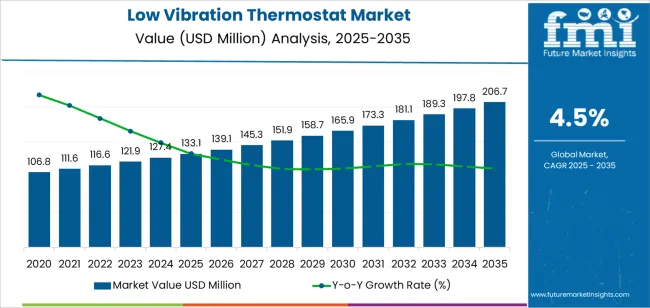
| Period | Primary Revenue Buckets | Share | Notes |
|---|---|---|---|
| Today | New system sales (laboratory grade, industrial grade) | 48% | Capex-led, research facility expansion purchases |
| Accessories & attachments | 22% | Sample holders, cooling units, probes | |
| Service & maintenance contracts | 20% | Calibration support, temperature verification | |
| Upgrades & retrofits | 10% | Control enhancement, capacity expansion | |
| Future (3-5 yrs) | Advanced control systems | 44-48% | Digital integration, multi-zone temperature control |
| Digital monitoring & analytics | 16-20% | Real-time stability tracking, predictive maintenance | |
| Service-as-a-subscription | 14-18% | Performance guarantees, calibration programs | |
| Accessories & consumables | 12-16% | Specialized chambers, thermal insulation | |
| Validation & calibration services | 8-12% | Regulatory support, quality documentation | |
| Data services | 4-6% | Temperature optimization, experimental analytics |
| Metric | Value |
|---|---|
| Market Value (2025) | USD 133.1 million |
| Market Forecast (2035) | USD 206.7 million |
| Growth Rate | 4.5% CAGR |
| Leading Technology | Laboratory Grade |
| Primary Application | Industrial Manufacturing Segment |
The market demonstrates strong fundamentals with laboratory grade thermostat systems capturing a dominant share through advanced temperature stability capabilities and precision measurement optimization. Industrial manufacturing applications drive primary demand, supported by increasing quality control and precision manufacturing requirements. Geographic expansion remains concentrated in developed markets with established research infrastructure, while emerging economies show accelerating adoption rates driven by industrial modernization initiatives and rising quality standards.
Primary Classification: The market segments by grade into laboratory grade and industrial grade systems, representing the evolution from basic temperature control equipment to sophisticated precision solutions for comprehensive research and manufacturing optimization.
Secondary Classification: Application segmentation divides the market into industrial manufacturing, biomedical, laboratory, and other sectors, reflecting distinct requirements for temperature stability, operational precision, and measurement accuracy standards.
Regional Classification: Geographic distribution covers North America, Latin America, Western Europe, Eastern Europe, East Asia, South Asia Pacific, and Middle East & Africa, with developed markets leading adoption while emerging economies show accelerating growth patterns driven by research infrastructure expansion programs.
The segmentation structure reveals technology progression from standard temperature control equipment toward sophisticated stability systems with enhanced precision and vibration-free capabilities, while application diversity spans from industrial facilities to biomedical laboratories requiring precise temperature-sensitive measurement solutions.
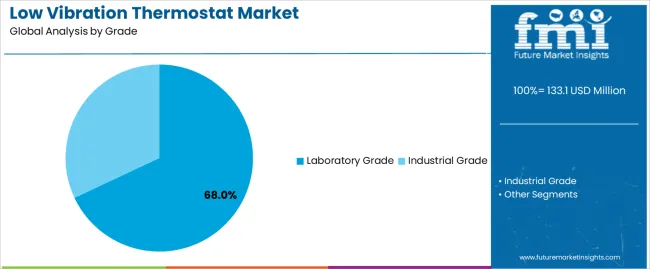
Market Position: Laboratory Grade thermostat systems command the leading position in the low vibration thermostat market with 68% market share through advanced temperature stability features, including superior precision control, operational consistency, and measurement optimization that enable research facilities to achieve optimal experimental accuracy across diverse laboratory and biomedical environments.
Value Drivers: The segment benefits from research facility preference for reliable temperature control systems that provide consistent stability performance, reduced vibration interference, and operational precision optimization without requiring significant infrastructure modifications. Advanced design features enable automated temperature regulation, stability maintenance, and integration with existing laboratory equipment, where operational performance and measurement accuracy represent critical research requirements.
Competitive Advantages: Laboratory Grade thermostat systems differentiate through proven operational reliability, consistent temperature characteristics, and integration with sensitive measurement instruments that enhance research effectiveness while maintaining optimal stability standards suitable for diverse laboratory and biomedical applications.
Key market characteristics:
Industrial Grade thermostat systems maintain a 32% market position in the low vibration thermostat market due to their durability properties and heavy-duty construction advantages. These systems appeal to facilities requiring continuous operation capability with competitive pricing for manufacturing applications. Market growth is driven by industrial expansion, emphasizing reliable temperature control solutions and operational efficiency through reinforced system designs.

Market Context: Industrial manufacturing applications demonstrate the highest growth rate in the low vibration thermostat market with 5.1% CAGR due to widespread adoption of precision temperature control systems and increasing focus on quality manufacturing optimization, operational consistency, and production quality applications that maximize output reliability while maintaining stability standards.
Appeal Factors: Manufacturing facility operators prioritize system reliability, temperature precision, and integration with existing production equipment that enables coordinated quality control operations across multiple production lines. The segment benefits from substantial manufacturing investment and automation programs that emphasize the acquisition of precision temperature control systems for quality optimization and production consistency applications.
Growth Drivers: Manufacturing expansion programs incorporate low vibration thermostats as standard equipment for quality control operations, while precision manufacturing growth increases demand for stable temperature capabilities that comply with quality standards and minimize measurement variability.
Market Challenges: Varying production requirements and environmental complexity may limit system standardization across different facilities or manufacturing scenarios.
Application dynamics include:
Biomedical applications capture market share through comprehensive temperature control requirements in pharmaceutical research, clinical laboratories, and medical device testing. These facilities demand precise temperature control systems capable of operating with sensitive biological samples while providing effective stability access and operational reliability capabilities.
Laboratory applications account for market share, including academic research institutions, analytical testing facilities, and materials science requiring specialized temperature control capabilities for experimental precision and measurement accuracy.
| Category | Factor | Impact | Why It Matters |
|---|---|---|---|
| Driver | Growing precision measurement demand & research complexity (advanced materials, nanotechnology applications) | ★★★★★ | Expanding precision research requirements drive consistent demand for vibration-free temperature control; measurement accuracy becomes essential for experimental validity and data quality. |
| Driver | Quality control standards & manufacturing precision (ISO requirements, process validation) | ★★★★☆ | Stricter quality requirements turn precision temperature control from optional to mandatory; validation documentation and stable conditions become operational necessities. |
| Driver | Biomedical research expansion & pharmaceutical development (drug discovery, biologics testing) | ★★★★☆ | Growing pharmaceutical R&D requires specialized temperature control; biomedical applications and temperature-sensitive testing create sustained market opportunities. |
| Restraint | High capital investment & calibration costs (especially for laboratory grade systems) | ★★★★☆ | Small research facilities and laboratories defer purchases; increases price sensitivity and slows advanced equipment adoption in resource-limited settings. |
| Restraint | Technical expertise requirements & maintenance complexity | ★★★☆☆ | Smaller facilities face staffing challenges and training requirements, limiting operational capability and increasing dependency on service providers. |
| Trend | Digital integration & smart laboratory systems | ★★★★★ | IoT connectivity, cloud-based monitoring, and data analytics transform operations; digital integration and predictive maintenance become core value propositions. |
| Trend | Miniaturization & compact designs | ★★★★☆ | Space-constrained laboratories need compact solutions; modular designs and benchtop systems drive competition toward flexible installation options. |
The low vibration thermostat market demonstrates varied regional dynamics with Growth Leaders including China (6.1% growth rate) and India (5.6% growth rate) driving expansion through research infrastructure development initiatives and industrial modernization programs. Steady Performers encompass Germany (5.2% growth rate), Brazil (4.7% growth rate), and developed regions, benefiting from established research systems and precision measurement technology adoption. Emerging Markets feature United States (4.3% growth rate) and developed regions, where laboratory advancement and quality control standardization support consistent growth patterns.
Regional synthesis reveals East Asian markets leading adoption through research expansion and industrial development, while South Asian countries maintain rapid expansion supported by scientific infrastructure modernization and manufacturing quality requirements. Western European markets show moderate growth driven by laboratory applications and precision measurement trends.
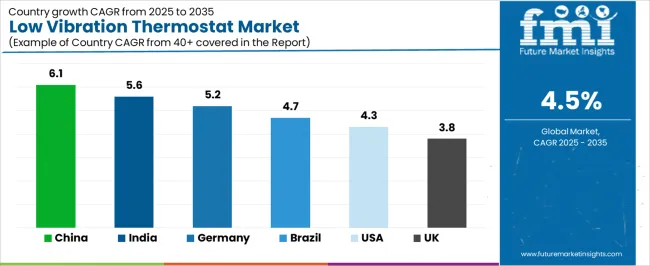
| Region/Country | 2025-2035 Growth | How to win | What to watch out |
|---|---|---|---|
| China | 6.1% | Focus on cost-effective precision | Localization requirements; price competition |
| India | 5.6% | Lead with value systems | Infrastructure gaps; skilled technician shortage |
| Germany | 5.2% | Offer premium stability systems | Over-engineering; lengthy validation cycles |
| Brazil | 4.7% | Value-oriented solutions | Currency fluctuations; import duties |
| USA | 4.3% | Provide calibration support | Market maturity; competitive pressure |
| UK | 3.8% | Push digital integration | Budget constraints; procurement complexity |

China establishes fastest market growth through aggressive research infrastructure development programs and comprehensive industrial quality improvement, integrating advanced low vibration thermostats as standard components in laboratory research and manufacturing quality control installations. The country's 6.1% growth rate reflects government initiatives promoting scientific research and industrial modernization that mandate the use of precision temperature control systems in research and manufacturing facilities. Growth concentrates in major scientific centers, including Beijing, Shanghai, and Shenzhen, where research technology development showcases integrated temperature control systems that appeal to laboratory operators seeking advanced measurement optimization capabilities and experimental precision applications.
Chinese manufacturers are developing cost-effective temperature control solutions that combine domestic production advantages with advanced operational features, including digital control capabilities and enhanced stability characteristics. Distribution channels through scientific equipment suppliers and laboratory service distributors expand market access, while government support for research infrastructure supports adoption across diverse laboratory and industrial segments.
Strategic Market Indicators:
In Bangalore, Mumbai, and Hyderabad, research facilities and manufacturing operations are implementing advanced low vibration thermostats as standard equipment for precision measurement and quality control applications, driven by increasing government research investment and industrial modernization programs that emphasize the importance of temperature stability capabilities. The market holds a 5.6% growth rate, supported by government scientific initiatives and infrastructure development programs that promote precision temperature control systems for research and manufacturing facilities. Indian operators are adopting temperature control systems that provide consistent operational performance and stability features, particularly appealing in urban regions where measurement precision and experimental accuracy represent critical operational requirements.
Market expansion benefits from growing research infrastructure capabilities and technology adoption programs that enable local production of temperature control equipment for laboratory and industrial applications. Technology adoption follows patterns established in scientific equipment, where reliability and precision drive procurement decisions and operational deployment.
Market Intelligence Brief:
Germany establishes technology leadership through comprehensive research programs and advanced laboratory infrastructure development, integrating low vibration thermostats across research and manufacturing applications. The country's 5.2% growth rate reflects established scientific relationships and mature temperature control technology adoption that supports widespread use of precision systems in research and industrial quality control facilities. Growth concentrates in major scientific centers, including Baden-Württemberg, Bavaria, and North Rhine-Westphalia, where research technology showcases advanced temperature control deployment that appeals to laboratory operators seeking proven precision capabilities and operational stability applications.
German equipment providers leverage established distribution networks and comprehensive service capabilities, including calibration programs and maintenance support that create customer relationships and operational advantages. The market benefits from mature quality standards and research requirements that mandate temperature control system use while supporting technology advancement and operational optimization.
Market Intelligence Brief:
Brazil's market expansion benefits from diverse research demand, including laboratory modernization in São Paulo and Rio de Janeiro, manufacturing facility upgrades, and government scientific programs that increasingly incorporate temperature control solutions for precision measurement applications. The country maintains a 4.7% growth rate, driven by rising research activity and increasing recognition of precision temperature control benefits, including experimental accuracy and enhanced measurement reliability.
Market dynamics focus on cost-effective temperature control solutions that balance advanced operational performance with affordability considerations important to Brazilian research operators. Growing scientific infrastructure creates continued demand for modern temperature control systems in new facility development and laboratory modernization projects.
Strategic Market Considerations:
United States establishes market leadership through comprehensive research programs and advanced laboratory infrastructure development, integrating low vibration thermostats across research and manufacturing applications. The country's 4.3% growth rate reflects established scientific relationships and mature temperature control technology adoption that supports widespread use of precision systems in research and industrial quality control facilities. Growth concentrates in major research centers, including Massachusetts, California, and the Research Triangle regions, where scientific technology showcases mature temperature control deployment that appeals to laboratory operators seeking proven precision capabilities and measurement accuracy applications.
American equipment providers leverage established distribution networks and comprehensive service capabilities, including validation programs and calibration support that create customer relationships and operational advantages. The market benefits from mature quality standards and research requirements that mandate temperature control system use while supporting technology advancement and measurement optimization.
Market Intelligence Brief:
United Kingdom's scientific technology market demonstrates low vibration thermostat deployment with documented operational effectiveness in research applications and manufacturing facilities through integration with existing laboratory systems and quality control infrastructure. The country leverages scientific expertise in research technology and precision systems integration to maintain a 3.8% growth rate. Research centers, including Cambridge, Oxford, and London, showcase installations where temperature control systems integrate with comprehensive laboratory platforms and facility management systems to optimize measurement operations and experimental effectiveness.
British research providers prioritize system precision and compliance in temperature control equipment procurement, creating demand for reliable systems with advanced features, including facility monitoring integration and automated stability systems. The market benefits from established scientific technology infrastructure and a commitment to invest in laboratory technologies that provide operational benefits and compliance with national research standards.
Market Intelligence Brief:

The European low vibration thermostat market is projected to grow from USD 50.3 million in 2025 to USD 77 million by 2035, registering a CAGR of 4.3% over the forecast period. Germany is expected to maintain its leadership position with a 38.3% market share in 2025, supported by its advanced research infrastructure and comprehensive precision measurement technology adoption.
France follows with a 24.8% share in 2025, driven by research modernization initiatives and industrial quality control requirements. The United Kingdom holds a 18.4% share through established research networks and laboratory standards. Italy commands a 10.7% share, while Spain accounts for 6.2% in 2025. The rest of Europe region is anticipated to gain momentum, expanding its collective share from 1.6% to 2.4% by 2035, attributed to increasing research adoption in Nordic countries and emerging Eastern European facilities implementing scientific infrastructure modernization programs.

Japan demonstrates advanced research integration in low vibration thermostats with comprehensive deployment across university laboratories and industrial research facilities. The country maintains steady growth through scientific quality emphasis and measurement precision requirements that support adoption of advanced temperature control systems. Japanese research facilities prioritize accuracy and reliability in laboratory equipment procurement, creating consistent demand for premium systems with advanced stability capabilities. Market characteristics include high adoption rates in urban research centers, established quality standards, and integration with comprehensive laboratory management systems that optimize experimental workflows and measurement programs.
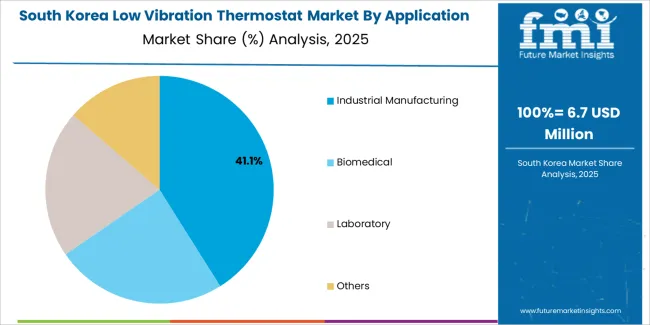
South Korea establishes scientific innovation leadership through rapid adoption of advanced research technologies and comprehensive laboratory modernization programs. The country leverages technology infrastructure and digital research initiatives to support low vibration thermostat deployment across major research networks and industrial facilities. Korean research facilities emphasize precision and automation capabilities, driving demand for laboratory grade systems with advanced digital integration. Market growth benefits from government research investment, technology-focused procurement standards, and increasing emphasis on scientific excellence that position South Korea as a leading market for advanced temperature control solutions.
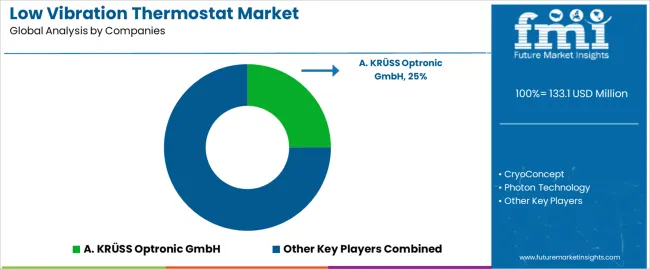
The low vibration thermostat market maintains a moderately fragmented structure with 12-18 credible players, where the top 4-5 companies hold approximately 58-65% market share by revenue. Leadership is maintained through comprehensive product portfolios spanning multiple temperature ranges and stability specifications, established research relationships, and global service networks that provide calibration support, validation programs, and technical training services. Market leaders differentiate through technological innovation combining precision temperature control with vibration isolation technologies, while also offering seamless integration with laboratory information management systems and data acquisition platforms.
Basic temperature control mechanisms and standard stability protocols are commoditizing, shifting competitive advantage toward value-added services including digital monitoring capabilities, predictive maintenance analytics, and comprehensive validation documentation. Margin opportunities concentrate in recurring revenue streams from calibration contracts, maintenance programs with performance guarantees, and service agreements that provide scheduled verification and system optimization. Companies investing in digital connectivity platforms and artificial intelligence-driven temperature optimization systems position themselves for premium market segments, while those focusing on compact designs and cost-effective precision solutions capture growth in emerging markets and smaller research facilities.
Strategic partnerships between thermostat manufacturers and analytical instrument companies create integrated offerings that simplify laboratory workflows and ensure measurement compatibility. The competitive landscape reveals increasing emphasis on total laboratory solutions rather than standalone temperature control equipment, with successful players offering comprehensive packages that address diverse measurement needs across industrial manufacturing, biomedical research, and academic laboratory applications. Technology convergence between traditional thermostat designs and advanced vibration isolation systems creates opportunities for companies with integrated platforms, while calibration capabilities and metrological expertise remain fundamental requirements for market participation across developed research systems.
| Stakeholder | What they actually control | Typical strengths | Typical blind spots |
|---|---|---|---|
| Global platforms | Distribution reach, comprehensive product lines, service networks | Broad availability, proven reliability, multi-region support | Innovation speed; emerging market pricing flexibility |
| Technology innovators | R&D capabilities; digital integration; advanced vibration isolation | Latest features first; attractive precision and stability | Service density outside core regions; customization complexity |
| Regional specialists | Local compliance, rapid delivery, calibration support | Close research relationships; pragmatic pricing; local standards | Technology gaps; talent retention in service |
| Service-focused ecosystems | Calibration programs, validation support, maintenance services | Lowest operational disruption; comprehensive support | Service costs if overpromised; technology advancement |
| Niche specialists | Specialized applications, custom solutions, research configurations | Win specialized and research applications; flexible configurations | Scalability limitations; narrow market focus |
| Item | Value |
|---|---|
| Quantitative Units | USD 133.1 million |
| Grade | Laboratory Grade, Industrial Grade |
| Application | Industrial Manufacturing, Biomedical, Laboratory, Others |
| Regions Covered | North America, Latin America, Western Europe, Eastern Europe, East Asia, South Asia Pacific, Middle East & Africa |
| Countries Covered | United States, China, Germany, India, United Kingdom, Japan, Brazil, France, South Korea, Canada, and 25+ additional countries |
| Key Companies Profiled | A. KRÜSS Optronic GmbH, CryoConcept, Photon Technology, Orion, Lauda, Quantum, CSIC PRIDE (NANJING) CRYOGENIC TECHNOLOGY, Beijing Physike Technology, Fermion Instrument Technology (Shanghai), Advanced Research Systems, Oxford, Anhui Zeyou Technology |
| Additional Attributes | Dollar sales by grade and application categories, regional adoption trends across East Asia, South Asia Pacific, and Western Europe, competitive landscape with precision measurement equipment manufacturers and laboratory suppliers, research facility preferences for temperature stability and system reliability, integration with laboratory information systems and measurement platforms, innovations in vibration isolation technology and precision enhancement, and development of advanced temperature control solutions with enhanced performance and measurement optimization capabilities. |
The global low vibration thermostat market is estimated to be valued at USD 133.1 million in 2025.
The market size for the low vibration thermostat market is projected to reach USD 206.7 million by 2035.
The low vibration thermostat market is expected to grow at a 4.5% CAGR between 2025 and 2035.
The key product types in low vibration thermostat market are laboratory grade and industrial grade.
In terms of application, industrial manufacturing segment to command 40.0% share in the low vibration thermostat market in 2025.






Full Research Suite comprises of:
Market outlook & trends analysis
Interviews & case studies
Strategic recommendations
Vendor profiles & capabilities analysis
5-year forecasts
8 regions and 60+ country-level data splits
Market segment data splits
12 months of continuous data updates
DELIVERED AS:
PDF EXCEL ONLINE
Low-Level Order Picker Pallet Truck Market Size and Share Forecast Outlook 2025 to 2035
Low Voltage Components Market Size and Share Forecast Outlook 2025 to 2035
Low Temperature Flexible Tester Market Size and Share Forecast Outlook 2025 to 2035
Low Light Imaging Market Forecast Outlook 2025 to 2035
Low Density Polyethylene Market Forecast and Outlook 2025 to 2035
Low-Temperature Cable Market Size and Share Forecast Outlook 2025 to 2035
Low Molecular Weight Chondroitin Sulfate Sodium Market Size and Share Forecast Outlook 2025 to 2035
Low Temperature Radiators Market Size and Share Forecast Outlook 2025 to 2035
Low Rolling Resistance Tire Market Size and Share Forecast Outlook 2025 to 2035
Low Temperature Commercial Boiler Market Size and Share Forecast Outlook 2025 to 2035
Low Emissivity Film Market Size and Share Forecast Outlook 2025 to 2035
Low Voltage Residential Switchgear Market Size and Share Forecast Outlook 2025 to 2035
Low Voltage Substation Market Size and Share Forecast Outlook 2025 to 2035
Low Migration Inks Market Size and Share Forecast Outlook 2025 to 2035
Low Voltage Distribution Panel Market Size and Share Forecast Outlook 2025 to 2035
Low Voltage Surge Arrester Market Size and Share Forecast Outlook 2025 to 2035
Low Density Polyethylene Packaging Market Size and Share Forecast Outlook 2025 to 2035
Low Temperature Insulation Materials Market Size and Share Forecast Outlook 2025 to 2035
Low Clearance Loaders Market Size and Share Forecast Outlook 2025 to 2035
Low Calorie Desserts Market Size and Share Forecast Outlook 2025 to 2035

Thank you!
You will receive an email from our Business Development Manager. Please be sure to check your SPAM/JUNK folder too.
Chat With
MaRIA